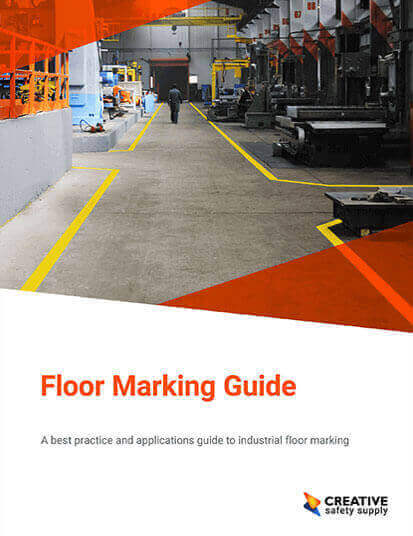
The organization possibilities available through floor markings are often overlooked in warehouse environments, having the potential to enhance safety, streamline operations, and maximize productivity when used well. In this article, we discuss some examples of how floor markings can be used to enhance a warehouse layout.
Loading areas
Assigning an area for loading and unloading vehicles is essential for warehouse operations, creating an area in which forklifts and pallet jacks can safely carry out their duties. The area should be clearly marked out to not only direct vehicles, but alert pedestrians of the moving vehicles in operation.
Storage of hazardous materials
For businesses who use chemicals or other hazardous materials, compliance with regulations must be followed to ensure the safety of those on site. Using floor markings to clearly state where these materials are stored will guide the correct handling. To alert other employees of the risks, color standards should be followed and other warning signs should also be present.
Aisle markings
Using brightly colored floor markings to clearly mark out the aisles with highly visible arrows helps to achieve a smooth traffic flow, guiding both vehicles and pedestrians on the direction of travel. To maintain the flow and help prevent congestion, highly durable floor marking materials should be used which can withstand heavy traffic and harsh conditions.
Defined workstations
Especially in areas of the business dealing with manufacturing and assembly, marking out individual workstations establishes a more organized system which can be followed by all employees. This helps to maintain a logical flow throughout the space so employees can work in an efficient environment without overlaps.
Pallet storage
Using floor markings to indicate the areas in which pallets should be stored makes it easier for employees to place and retrieve items. For busier environments with multiple storage areas, color coding is a good way to improve warehouse organization, using the floor markings to map out the different zones based on contents.
Emergency points
Health and safety is paramount, keeping workers and the site safe from hazards. To prepare for emergency situations, every business should designate specific areas for emergency exits, fire extinguishers, and first aid stations. To make sure these remain obvious to the eye and free from obstruction, using bright floor markings will draw the necessary attention.
Excess storage
Whether it be for seasonal goods, excess stock, or large orders, inventory should remain well managed to maintain organization. Floor markings can be used to assign an area to items that aren’t stored on pallets, giving everything a logical place that does not obstruct operations. Once the designated areas are marked out, the space can be utilized with signage and shelving racks to create an efficient system.
Picking and packing areas
To allow employees to quickly and accurately fulfill customer orders, creating a good system throughout the warehouse will help reduce errors and speed up the process. Floor markings can be used to mark out the areas, using colors to help workers identify the different sections.
Quality control
For businesses who inspect goods before they leave the site, appointing a dedicated quality control area through floor markings will ensure employees know exactly where to place the finished goods and do not mix these up with approved stock.
Similar How-To's
- How to Use a Pull System
- How to Use Floor Markings
- How to use Pipe Markings with the Proper Color Codes
- How to Choose a Muster Point
- How to Install SafetyTac
- How to Use a LabelTac Industrial Label Printer
- How to Organize Workshop Tools
- How to Implement Pipe Markings
- How to Establish An Emergency Evacuation Plan
